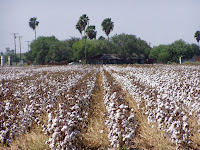Although these exist not only in South Texas, they are here and maybe surprising to be here in South Texas.
 Cotton is king. As kids, my brothers and neighbors would spend time in the cotton fields making believe we were working. Many times we did not make enough to cover the food we ate. The two pix were taken before the tropical storm "Don" came in. These plants are about 12 inches tall. All cotton is machine picked. The only way humans could pick this cotton would be on their knees.
Cotton is king. As kids, my brothers and neighbors would spend time in the cotton fields making believe we were working. Many times we did not make enough to cover the food we ate. The two pix were taken before the tropical storm "Don" came in. These plants are about 12 inches tall. All cotton is machine picked. The only way humans could pick this cotton would be on their knees. 
In the olden days the real pickers used 10-12 foot sacks. The younger pickers used 6 foot sacks or home-made smaller ones. The pickers pick from three rows, straddling one and picking from left and right. These were the pickers who depended on the crop for their survival.They would go up and back, weigh, unload, and back again.

I hated rows that stretched into the horizon. This type of row meant that it would be a long time before I could sit under the shade of the truck and drink cool water. The black and white pix are from the Internet archives.
The black and white pix are from the Internet archives.
 The black and white pix are from the Internet archives.
The black and white pix are from the Internet archives. As kids, cotton picking was a way to get us out of the house and maybe earn enough money to go to the movies.
Certainly Muslim places of worship are not unique to South Texas, but they are unusual, when you consider that 95% of the population is Mexican-American.
This building is fronted by another with the sign, "Muslim Society of South Texas." It is a beautiful copper dome in McAllen, Texas, a city of more than 100k residents. More surprising was to find a similar sign in my home town, Weslaco, population 30K. Although they have yet to build such a magnificent building, their presence is known. I regularly see a white van drive past my house, with two men. They both were white garb and a white woven beany. They stare my way as if to try and convert me.
Spell-check
Call 968-6108 for an "appiontment."
.
Good old-fashioned Mexican style barbecue is prepared by steaming the head of the steer and then stripping the meat off the bones. Eaten as tacos with corn tortillas and pico de gallo it has no equal. However, the
word in Spanish is "barbacoa" NOT "bardacoa." Who got the painting job? Needless to say, these businesses no longer exist. Both menudo and barbacoa are typically only sold on weekends.
As I drive around I encounter the odd and the unusual, for South Texas. I know that Scientology and Dianetics are all over the world, I just never expected to see this sign in the southernmost tip of Texas. I did not see any signs of Ron L. Hubbard or John Travolta.
Back in the day, cotton was king. Then citrus came into its own. Because of unpredictable freezes and droughts, cotton and citrus orchards were replaced by sorghum and sugar cane.
The sugar cane field was right across the road from the cotton field in the first pictures. Imperial Sugar has a refining plant in the area. There were no sorghum pictures to show as most of it has been harvested. Again, sugar cane and sorghum exist not only in South Texas, but these crops are here to stay.





The typos are great, too bad their spell check (F7) for us PC users) didn't work. Here we do not have many Muslims or Scientologists (or at least not a lot or enough to have temples) but we have several different sects of Buddhism, Portuguese Church of Christ (all signs in Portuguese) and as we learned from watching the 4th of July parade in Volcano Village a healthy Hari Krishna cult. We have a Catholic church in every village as well as various protestant denominations.
ReplyDeleteThe Big Island at one time had the largest sugar cane fields of all the islands but they are all gone now. C&H Sugar used to stand for "California & Hawaii" now it is California and Honduras. It seems that the Hondurans will process sugar for a lot less money than people in Hawai'i.
I just started a sugar patch with Native Hawaiian sugar. This is variety that the Hawaiians of old brought. I like it because it has a very dark purple stock instead of the green. When it is mature the bright green leaves contrasted with the stock is a nice addition to the garden.